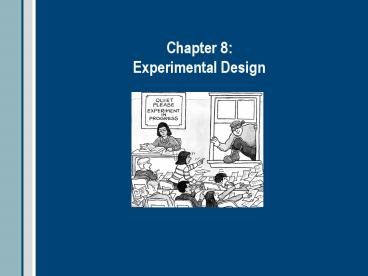Chapter 8: Experimental Design - PowerPoint PPT Presentation
1 / 23
Title:
Chapter 8: Experimental Design
Description:
Developmental Research Designs. Developmental psychologists often study the ways that individuals change as a function of age. ... – PowerPoint PPT presentation
Number of Views:99
Avg rating:3.0/5.0
Title: Chapter 8: Experimental Design
1
Chapter 8Experimental Design
2
Confounding and Internal Validity
- Experimental method has the advantage of allowing
a relatively unambiguous interpretation of the
results. - Manipulated independent variable
- - Create groups that differ in the levels of the
- variable
- Compares the groups in terms of their scores on
the dependent variable - - All other variables kept constant through
direct experimental control and/or randomization
3
Confounding and Internal Validity (cont)
- An experiment is said to have internal
validity when the results of an experiment can
confidently be attributed to the effect of the
independent variable.
4
Basic Experiments
- Simplest possible experimental design
- One independent variable with two levels (an
experimental group and a control group) - Randomization
- Experimental control
5
Basic Experiments (cont)
- The basic, simple experimental design can take on
of two forms - Posttest-only design
- 2. Pretest-posttest design
6
Basic Experiments (cont)
R random assignment to conditions
7
Basic Experiments (cont)
- Pretest-posttest design
- Same as a posttest-only design but adds a pretest
before the experimental manipulation - Allows the researcher to ascertain if the groups
are equivalent at the beginning of the experiment
8
Basic Experiments (cont)
- Advantages and Disadvantages of the two basic
designs - Advantages of the pretest-posttest design
- Assess equivalency with small sample size
- Select the participants for the experiment
- Assess the effects of mortality
9
Basic Experiments (cont)
- Disadvantages of the pretest-posttest design
- Time consuming and awkward to administer
- Sensitize participants to what is being studied
- Demand characteristics
- External validity
- Possible solutions disguise pretest,
- embed the pretest in another measure,
- concealed observation
10
Basic Experiments (cont)
- Assess directly the impact of the pretest by
using a Solomon four-group design - Half the participants receive only the posttest
- Half the participants receive both the
pretest and posttest
11
Assigning Participants to Experimental
Conditions
- Independent groups design
- Participants randomly assigned to conditions
- Participants are in only one group
Meaningfulness
12
Assigning Participants to Experimental
Conditions (cont)
- Repeated measures design
- The same participants are in all of the groups
Meaningfulness
13
Assigning Participants to Experimental
Conditions (cont)
- Advantages and disadvantages of repeated
measures designs - Advantages
- Fewer participants
- Extremely sensitive to statistical differences
- (more likely to detect an effect of the IV
on the DV)
14
Assigning Participants to Experimental
Conditions (cont)
- Disadvantages
- Order effects
- - Practice effects
- - Fatigue effects
- - Contrast effects
15
ExperimentalDesign
16
Assigning Participants to Experimental
Conditions (cont)
- Approaches to deal with order effects
- Counterbalancing techniques
- Complete counterbalancing
- Latin square
- Randomized blocks
- Time Interval between treatments
17
Assigning Participants to Experimental
Conditions (cont)
Complete counterbalancing
18
Assigning Participants to Experimental
Conditions (cont)
Latin square
19
Assigning Participants to Experimental
Conditions (cont)
- Matched pairs design ensures groups are
equivalent on the matching variable prior to the
IV - Match participants on a particular characteristic
(either the dependent measure or a variable
strongly related to the dependent variable). - After matching, randomly assign to experimental
conditions
20
Developmental Research Designs
- Developmental psychologists often study the ways
that individuals change as a function of age. - 1. Cross-sectional method measured at one
point - in time
- 2. Longitudinal method same group observed
at - different times as they get older
- 3. Sequential method combination of 1 2
21
Developmental Research Designs (cont)
- Design considerations
- Cohort effects
- Mortality effects
- Monetary costs
- Difficulty level
22
Developmental Research Designs (cont)
23
The End































